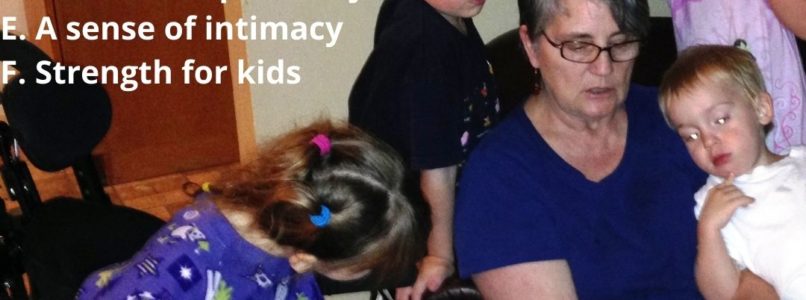 Technology has been a boon in so many ways. I am amazed at how well versed my nine-year-old grandson is in the use of technology. I watch other kids, and I am equally impressed. But technology, for kids, also has downsides. Here is one that I regularly see with the children that I interact with often; they have a more challenging time filling their time when technology isn’t available.
Technology has been a boon in so many ways. I am amazed at how well versed my nine-year-old grandson is in the use of technology. I watch other kids, and I am equally impressed. But technology, for kids, also has downsides. Here is one that I regularly see with the children that I interact with often; they have a more challenging time filling their time when technology isn’t available.
Because her kids are still relatively small, one of my daughters has some very consistent technology rules. Her kids must fill many hours of their day with ordinary play. This need to play is valuable because when kids play without adults, they develop their executive function skills, which are vital to becoming successful adults.
But children who have access to technology for many hours a day have a more challenging time engaging in inventive play with other kids. And this doesn’t just impact small children. I remember watching a group of teens sitting on the steps by my apartment. They were all together, but they were talking to each other on their phones. For over ten minutes, not a single word was spoken. No one looked up from their phones to even look at each other.
I watch my grands play video games with their friends. They aren’t in the same house. They are yelling and laughing with each other, but they cannot see each other’s body language and reactions in real-time. The way many kids play and interact with other kids has changed.
However, if we are wise, we will manage the technology use of our younger children. Of course, as they move into their teens, the time does come when you must let go more, but you can help them practice managing this two-edged sword for a while.
There are some good reasons for managing your childrens technology as well as your own:
1. Technology makes you grouchy – A study done by the Boston Medical Center revealed that parents who get absorbed by email, games, or other apps have more negative interactions with their children.
The Boston Medical Center study was conducted by Dr. Jenny Radesky, a fellow in developmental and behavioral pediatrics. Because she’s an expert on children’s behavior, she was curious as to how the allure of smartphones might affect the quality of time parents and their children spend together. What did they find? Radesky and her team reported there were “a lot of instances where there was very little interaction, harsh interaction or negative interaction” between the adults and the children.
2. Technology contributes to losing the ability to relate to others – remember those teens I observed? Dr. Wendy Sue Swanson of Seattle Children’s Hospital commented, “My concern is that if the device use becomes really excessive, and it replaces our day-to-day interactions, then kids won’t get much practice with having conversations, reading social cues, and responding sensitively to something that the other person expresses.” (“Don’t Text While Parenting—It Will Make You Cranky”).
A Wall Street Journal article describes “silent fluency” as “the ability to read cues like tone, body language, and facial expressions. Email and texts don’t convey empathy, tone, or subtext the way face-to-face or phone conversations do. We have to learn those things by interacting with real people.” (Bauerlein, “Why Gen-Y Johnny Can’t Read Nonverbal Cues”).
Larry Rosen, a well-known psychologist who has studied the psychology of Facebook interaction, wrote, “Our study showed that real-world empathy is more important for feeling as though you have solid social support.” (Larry Rosen, “Why Would Kids Who Spend More Time On Facebook Display More Empathy Online and In Real Life?”).
Isn’t that what we want in our families? Don’t we want our children to feel solidly supported? Don’t we want them to be able to support each other? Of course, we do. Most of us want this feeling in our family culture, but we won’t move as efficiently or effectively in the correct direction unless we model interactions between real people more often than we model interactions with technology.
3. Technology creates emotional distance and loneliness – Steiner-Adair interviewed 1,000 children between the ages of 4 and 18 to learn about their parents’ use of their mobile devices and how the kids felt about it. The words they used over and over again were “sad, mad, angry and lonely.” (Neighmond, “For the Children’s Sake, Put Down That Smartphone”).
In short, kids and parents begin to experience an emotional disconnect. This can prove problematic as children grow and experience more challenging things because who can they talk to? It won’t be those with whom they feel little connection or trust. There’s a sense of isolation and loneliness when technology is too prevalent in a home.
Turning away from technology and getting Present with your children will pay huge dividends when they become youth and young adults. It will impact your long-term adult relationship as well.
4. Technology gives the illusion of naughty children and makes for weary parents – Technology can make kids act out. Review #1 above. It can make kids cranky, and if you are too involved in your tech, they will act out to get your attention.
There are many books out there on how technology can affect your children’s brains for good and ill. There are also a ton of books on how to help not just your kids, but your family manage technology. Here is the thing that I think will help you the most – remember your summers. Those lazy days were filled with running and jumping and laughing and playing. And when you remember, you will want that a bit more of that for your kids.
So how do you manage technology?
As I said, there are lots of books on the subject but here are three tips to get you started:
1. Have set times when you and your children will use technology. I know a mom
who realized checking her computer first thing in the morning was messing up her day. She decided to turn the computer off each night before bed and leave it off until afternoon the next day. It’s made a world of difference
2. Try unplugging. Have a day, a few times a week, each month, or each year when you completely unplug. A few years ago, I shared how one family goes screen-free once a month each year. Yup, a whole month! Unplugging gives your mind a break. It re-energizes you. It puts you back in control.
Sunday is my day to unplug. I don’t scroll through social media, look things up online, write or answer emails, send texts, etc. Instead, I use my phone to visit with friends in real, live conversations. It is refreshing and rejuvenates my spirit.
3. Decide on technology-free times for your family. Which regular family activities will be technology-free? During those times, turn off all technology, including landline phones as well as cell phones. There are many possibilities—mealtime, family reading time, car time, bedtime, and family meeting/activity nights, to name a few.
When we take control of our use of technology and help our family members learn to control theirs, it is easier to feel connected and supported as a family; it is easier to create a family culture of Presence.






 For many families, school has begun in earnest. Whether you are using the public system, a private system, or homeschooling, September usually means we are deep into it. Some years back, I wrote an article about how to help children remain lifelong learners, to become lovers of learning.
For many families, school has begun in earnest. Whether you are using the public system, a private system, or homeschooling, September usually means we are deep into it. Some years back, I wrote an article about how to help children remain lifelong learners, to become lovers of learning.
 How it all started!
How it all started!
 Recently, I was up until 12:30 a.m.
Recently, I was up until 12:30 a.m. The other day when I went out to water the garden,
The other day when I went out to water the garden, the same thing almost every day. First, I walk out to the back faucet and turn on the water. Then I go through the garden gate and turn on the second faucet which lets water into the garden.
the same thing almost every day. First, I walk out to the back faucet and turn on the water. Then I go through the garden gate and turn on the second faucet which lets water into the garden. When we moved with Jodie’s family this last time, we had to build a kitchen for my family, where a storage room had been. Everyone tried to talk me out of the light I choose to go over the kitchen sink. After all, it was a bathroom fixture. I didn’t care, I loved how it looked, and it was so illuminating. Every time I use that light, I am amazed at how much better I can see. The odd thing is that I don’t always use this extra light. Sometimes I will be washing potatoes or doing dishes and think, “I have enough light.” And I do, sort of. Then I will have a change of heart and flip the switch that is right in front of me, and voila! I can see so much better. There are other times when I know that I need more light, and I hurriedly flip the switch. I am always shocked at how much better I can see and how much more efficiently I can do whatever job I am doing because the details are more apparent.
When we moved with Jodie’s family this last time, we had to build a kitchen for my family, where a storage room had been. Everyone tried to talk me out of the light I choose to go over the kitchen sink. After all, it was a bathroom fixture. I didn’t care, I loved how it looked, and it was so illuminating. Every time I use that light, I am amazed at how much better I can see. The odd thing is that I don’t always use this extra light. Sometimes I will be washing potatoes or doing dishes and think, “I have enough light.” And I do, sort of. Then I will have a change of heart and flip the switch that is right in front of me, and voila! I can see so much better. There are other times when I know that I need more light, and I hurriedly flip the switch. I am always shocked at how much better I can see and how much more efficiently I can do whatever job I am doing because the details are more apparent.
 All my life I have wanted a bed with beautiful bed pillows. It wasn’t possible for me to have this in my family of origin for many reasons. When I was newly married, it wasn’t a real option either. However, I did come to a place where I could finally have them. But my husband doesn’t want to move a big pillow to take a nap, rest after work, or when he goes to bed. He can’t see the point. Mostly, he isn’t aware whether they are on the bed or not. He doesn’t see them. They aren’t even part of his thinking.
All my life I have wanted a bed with beautiful bed pillows. It wasn’t possible for me to have this in my family of origin for many reasons. When I was newly married, it wasn’t a real option either. However, I did come to a place where I could finally have them. But my husband doesn’t want to move a big pillow to take a nap, rest after work, or when he goes to bed. He can’t see the point. Mostly, he isn’t aware whether they are on the bed or not. He doesn’t see them. They aren’t even part of his thinking. look beautiful. Raising seven children and growing up the oldest of nine, you know that there were NEVER unused towels in the bathroom.
look beautiful. Raising seven children and growing up the oldest of nine, you know that there were NEVER unused towels in the bathroom. When I decided to stop suffering, this is what I did. I acquired a small shelf which I put in my bathroom. I got it from my mom. I trifold the towels and keep them color-coordinated, and it looks terrific. When I am in the bathroom doing whatever, I look at the towel rack, and it feels so lovely. It is perfect. I don’t mind Don’s unfolded towel or the fact that my color-coordinated towels aren’t hanging up. When I go into the bathroom, I see that I have this orderly, beautiful rack of towels. It feels satisfying to me.
When I decided to stop suffering, this is what I did. I acquired a small shelf which I put in my bathroom. I got it from my mom. I trifold the towels and keep them color-coordinated, and it looks terrific. When I am in the bathroom doing whatever, I look at the towel rack, and it feels so lovely. It is perfect. I don’t mind Don’s unfolded towel or the fact that my color-coordinated towels aren’t hanging up. When I go into the bathroom, I see that I have this orderly, beautiful rack of towels. It feels satisfying to me.
 I am a
I am a 
 When I mentor moms, I hear about all the things that aren’t working. That is what they come to me for – for perspective, to see with new eyes. I enjoy this process of sorting it out. We often begin with family systems, so things start to work better.
When I mentor moms, I hear about all the things that aren’t working. That is what they come to me for – for perspective, to see with new eyes. I enjoy this process of sorting it out. We often begin with family systems, so things start to work better.
 My sister flew to Philadelphia to see her son and his family. Michael picked her up at the airport, and they drove to New Jersey. He is in the military, and she was very anxious to see them all.
My sister flew to Philadelphia to see her son and his family. Michael picked her up at the airport, and they drove to New Jersey. He is in the military, and she was very anxious to see them all.